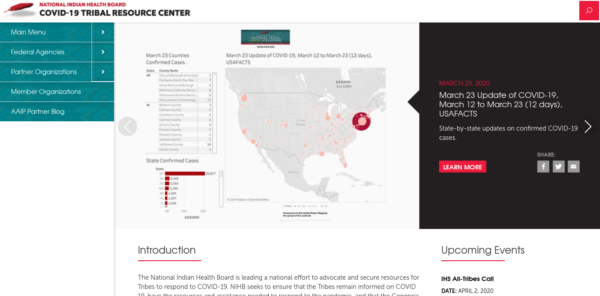
- Details
- By Native News Online Staff
WASHINGTON — The National Indian Health Board this week launched a new website with “tribally specific” Coronavirus-related developments, tools and information: nihb.org/covid-19/
The new COVID-19 Tribal Resource Center site targets tribal leaders, tribal health workers and administrators, tribal community members and advocates for tribal health policy. The site has six main areas of information:
- Updates and Communications from NIHB and federal agencies;
- Community Health Tools section has fact sheets on vulnerable populations like elders and people with compromised immune systems;
- Advocacy Tools has legislative alerts, letters to Congress and summaries on the COVID-19 relief funding packages;
- Tribal Response Plans shares Tribe-specific resources;
- Administration and Agency Responses has guidance and waivers from federal agencies;
- Upcoming calls and webinars.
“Tribes told the National Indian Health Board that they needed more resource materials on Coronavirus and we listened,” said NIHB CEO Stacy A. Bohlen. “The NIHB COVID-19 Tribal Resource Center website is the place for Tribes and Tribal health authorities to gather resources to help educate and protect Native youth, elders and families.
“During this public health crisis, NIHB seeks to ensure that the Tribes remain informed on COVID-19 and have the resources and assistance needed to respond to the pandemic. The website will help bring awareness of the disease to tribal members.”
In early March, NIHB responded to the growing concern about the COVID-19 outbreak and developed a survey to assess Tribal needs and resources. Through the survey results, NIHB learned that Tribes are seeking information on emergency preparedness and best practices for transmission prevention for community members and key risk groups. The survey also showed that Tribes are concerned about the shortage of personal protective equipment, hygiene products and staff shortages, according to an NIHB release.
NIHB also partnered with member organizations, including the Association of American Indian Physicians (AAIP), to share expertise and information from Native physicians. AAIP members are contributing a blog every week for the Resource Center website that focuses on a series of topics related to COVID-19 through a Native physician's lens. Blog topics include traditional health, Coronavirus effects on Native youth and protections for vulnerable populations including pregnant mothers and Tribal citizens living with chronic illnesses, diabetes and cardio-vascular ailments.
The COVID-19 Tribal Resource Center website is part of the National Indian Health Board’s greater communication strategy to ensure Tribes are informed and engaged as this pandemic continues. In addition to the website, NIHB is hosting national calls and webinars for Tribal leaders to provide input and to gain information from key federal agency officials.
“Be assured that NIHB board members and staff are working for Tribes and tribal community members during the COVID-19 pandemic,” Bohlen said.
More Stories Like This
Native News Weekly (August 25, 2024): D.C. BriefsUS Presidents in Their Own Words Concerning American Indians
Two Murdered on Colville Indian Reservation
NDAA passes House; Lumbee Fairness Act Advances
NFL, Vikings to Host Native All-American Game, Youth Flag Clinic
Help us defend tribal sovereignty.
At Native News Online, our mission is rooted in telling the stories that strengthen sovereignty and uplift Indigenous voices — not just at year’s end, but every single day.
Because of your generosity last year, we were able to keep our reporters on the ground in tribal communities, at national gatherings and in the halls of Congress — covering the issues that matter most to Indian Country: sovereignty, culture, education, health and economic opportunity.
That support sustained us through a tough year in 2025. Now, as we look to the year ahead, we need your help right now to ensure warrior journalism remains strong — reporting that defends tribal sovereignty, amplifies Native truth, and holds power accountable.
 The stakes couldn't be higher. Your support keeps Native voices heard, Native stories told and Native sovereignty defended.
The stakes couldn't be higher. Your support keeps Native voices heard, Native stories told and Native sovereignty defended.
Stand with Warrior Journalism today.
Levi Rickert (Potawatomi), Editor & Publisher

